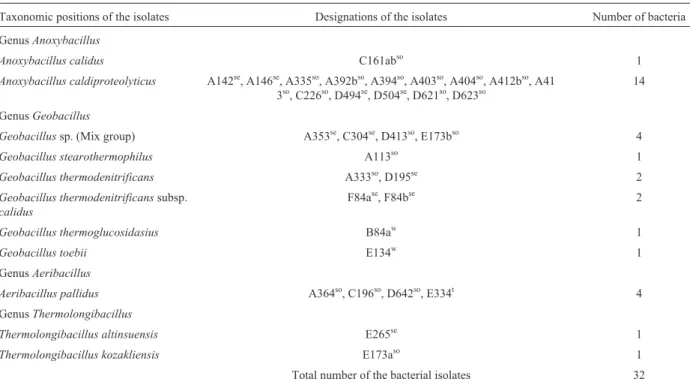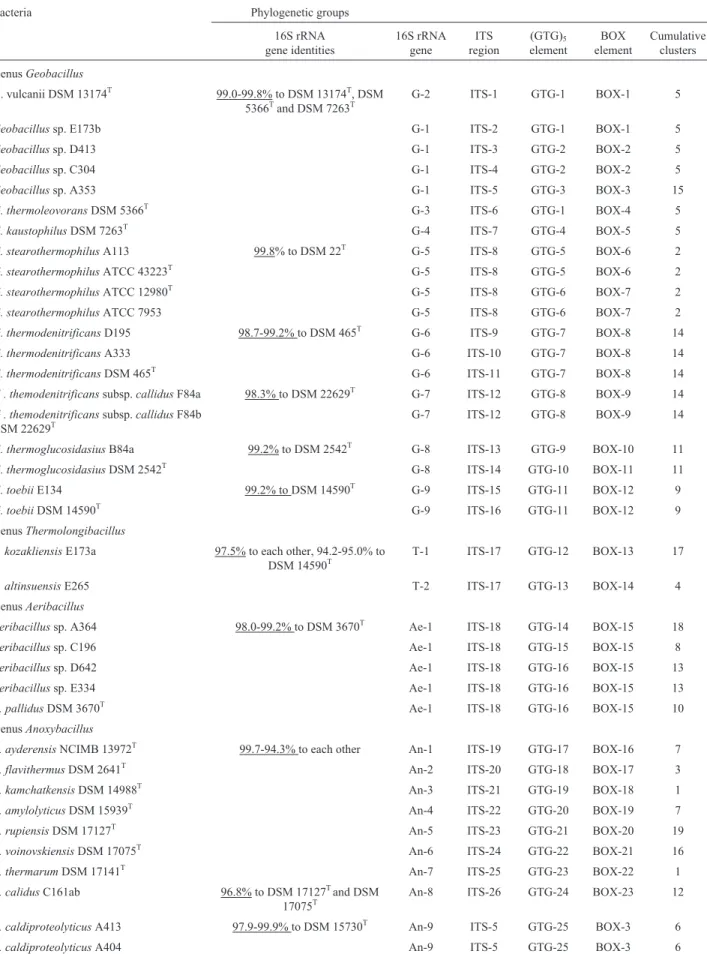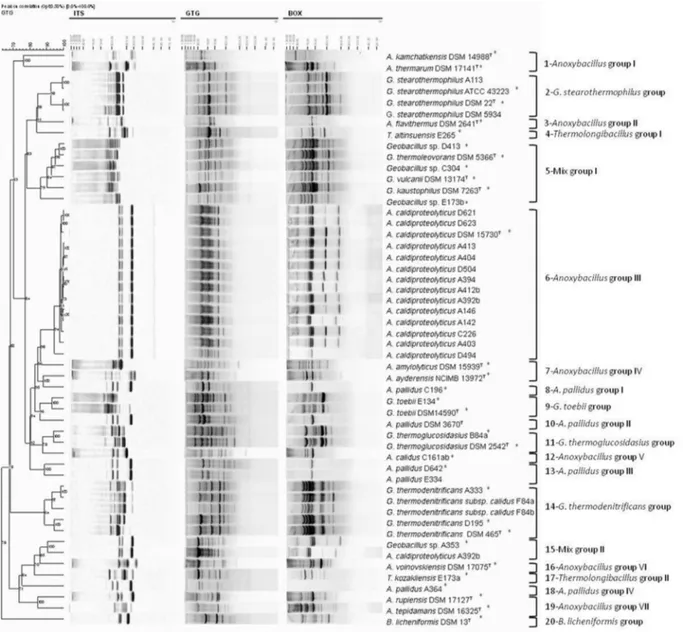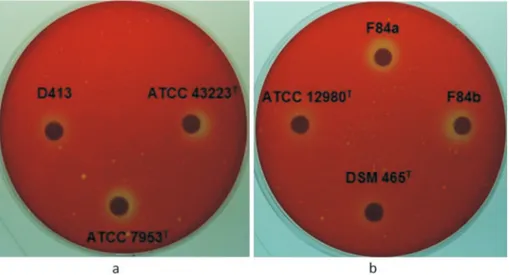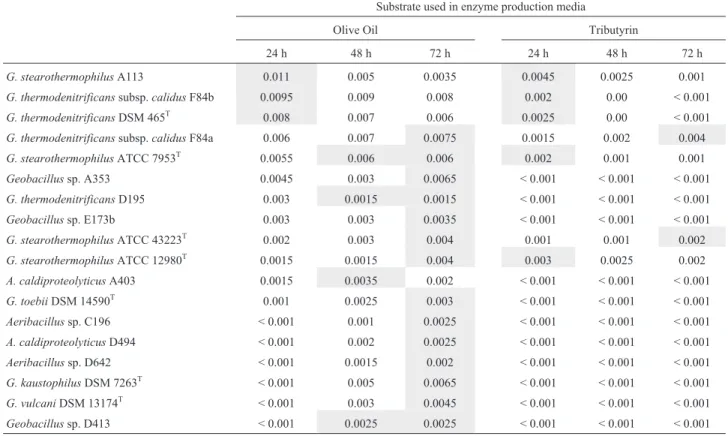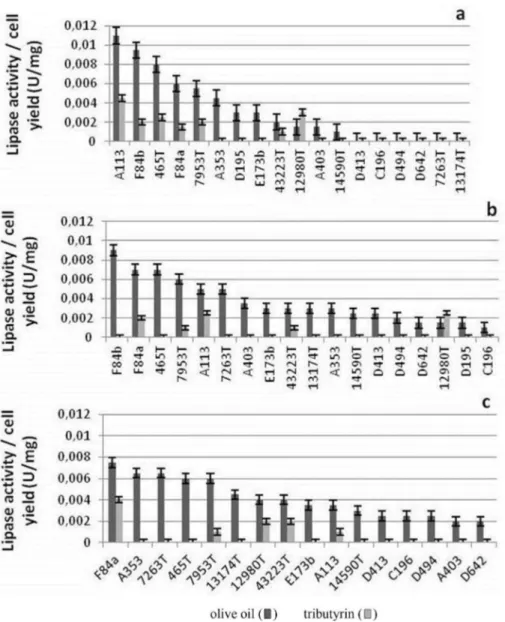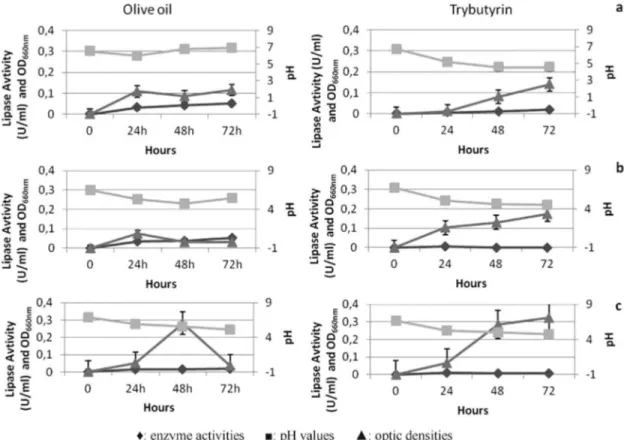The genotypic diversity and lipase production of some thermophilic bacilli
from different genera
Melih Koc
1, Cumhur Cokmus
2, Arzu Coleri Cihan
1 1Biology Department, Faculty of Science, Ankara University, Ankara, Turkey.
2
Konya Food & Agriculture University, Dede Korkut Mah., Konya, Turkey.
Submitted: November 13, 2014; Approved: April 12, 2015.
Abstract
Thermophilic 32 isolates and 20 reference bacilli were subjected toRep-PCR and ITS-PCR finger-printing for determination of their genotypic diversity, before screening lipase activities. By these methods, all the isolates and references could easily be differentiated up to subspecies level from each other. In screening assay, 11 isolates and 7 references were found to be lipase producing. Their extracellular lipase activities were measured quantitatively by incubating in both tributyrin and olive oil broths at 60 °C and pH 7.0. During the 24, 48 and 72-h period of incubation, the changes in the lipase activities, culture absorbance, wet weight of biomass and pH were all measured. The activity was determined by usingpNPB in 50 mM phosphate buffer at pH 7.0 at 60 °C. The lipase production of the isolates in olive oil broths varied between 0.008 and 0.052, whereas these values were found to be 0.002-0.019 (U/mL) in the case of tyributyrin. For comparison, an index was established by divid-ing the lipase activities to cell biomass (U/mg). The maximum thermostable lipase production was achieved by the isolates F84a, F84b, and G. thermodenitrificans DSM 465T (0.009, 0.008 and 0.008 U/mg) within olive oil broth, whereasG. stearothermophilusA113 displayed the highest lipase activity than its type strain in tyributyrin. Therefore, as some of these isolates displayed higher activi-ties in comparison to references, new lipase producing bacilli were determined by presenting their genotypic diversity with DNA fingerprinting techniques.
Key words:endospore-forming bacilli, screening, thermostable lipase, ITS-PCR,Rep-PCR.
Introduction
Isolation of novel thermophilic bacilli by polyphasic approach has received considerable attention since they in-clude the species of industrial, biotechnological and envi-ronmental interest (Derekovaet al., 2008). These thermo-philes play an important role in applications such as enzymatic synthesis of novel oligosaccharides, in hydroly-sis of starch to glucose, in industrial fermentation pro-cesses, in biopolymer and biodiesel production as well as in textile and detergent industries due to their unique thermo-stable enzymes (Hough and Danson, 1999; Haki and Rakshit, 2003). In order to screen isolates producing novel thermostable enzymes that might be useful in industrial ap-plications, the taxonomic studies are of importance in de-termining the phenotypic and genotypic diversity of these
microorganisms, and placing these bacilli in appropriate taxonomic levels by characterizing novel species from these natural thermal habitats, harbouring undiscovered microorganisms (Moraet al., 1998). This approach clusters a great number of similar bacteria belonging to the same ge-nus, and includes obtaining information about these clus-ters with both definitive phenotypic and DNA-directed genotypic fingerprinting methods which amplify the inter-genic transcribed spacers (ITS) and the repetitive extra-genic palindromic elements (Rep-elements), (Vanee-choutteet al., 1992; Whiteet al., 1993).
Moreover, lipases (triacylglyserol hydrolases, E.C.3.1.1.3) catalyze the hydrolysis of triacylglyserol to free fatty acids and glycerol. In addition, lipases can achieve esterification, interesterification, acidolysis, alcoholysis and aminolysis reactions (Josephet al., 2008).
DOI: http://dx.doi.org/10.1590/S1517-838246420140942
Send correspondence to A.C. Cihan. Faculty of Science, Department of Biology, Ankara University, 06100 Ankara, Turkey. E-mail: arzucoleri@gmail.com, acihan@science.ankara.edu.tr.
Thermophilic bacilli are the natural source of many mostable enzymes, and of those from thermozymes, ther-mostable lipases have received attention in both structural studies and industrial applications as they show high stabil-ity at elevated temperatures and in organic solvents (Bornscheueret al., 1994; Jaeger et al., 1994). Thermo-stable lipases have been described and characterized in a few thermophilic species, includingGeobacillus thermo-leovarans ID-1 (Lee et al., 1999), Geobacillus stearo-thermophilusL1 (Kambourovaet al., 2003),Geobacillus zalihae (Rahmanet al., 2007), Geobacillus sp. TW1 (Li and Zhang, 2005), andAnoxybacillus kamchatkensisKW 12 (Olusesanet al., 2009). In this study, we represented the data of lipase production capacities of totally 32 thermo-philic, endospore-forming bacilli by comparing the results with 20 reference strains tested. Furthermore, high amounts of thermostable lipase producing isolates were determined for further studies in addition with displaying their geno-typic diversity by representing the ITS-PCR andRep-PCR DNA fingerprints.
Materials and Methods
Bacterial isolates and reference strains
Totally 32 thermophilic bacterial isolates and 20 ref-erence strains were used for the screening of lipase produc-tion. The 16S rRNA gene sequence analyses of these ther-mophilic isolates were formerly determined from our previous studies and their gene sequences were found in GenBank databases (Cihan et al., 2011). These thermo-philic bacilli were found to belong to totally four different genera fromAnoxybacillus(15 isolates),Geobacillus(11), Aeribacillus(4) andThermolongibacillus(2). Twenty one samples of water (2), soil (13), sediments (8) or tree branch (1) were collected from different hot springs and high-temperature well pipelines of geographically widespread locations in Turkey. These regions are located in two geo-graphically separated areas in Turkey: Aegean Region and Middle Anatolian Region. Of those geothermal regions, Aydin (Region A; 27°51’ E, 37°51’ N), Denizli (Region C; 29°06’ E, 37°46’ N) and Izmir (Region D; 27°09’ E, 38°25’ N) provinces are in the Aegean Region, whereas Nevsehir (Region E; 34°43’ E, 38°38’ N) and Ankara (Re-gion F; 32°52’ E, 39°56’ N) provinces are located in the Middle Anatolian Region of Turkey. The isolates were des-ignated according to their isolated provinces and the sam-ple numbers. The designation and origin of the 32 isolates, their detailed taxonomic position and the reference strains used in this study are presented below in Table 1.
PCR based fingerprinting analyses ofRepelements and Intergenic 16S-23S rRNA genes
Repetitive Elements-PCR (Rep-PCR) genomic fingerprintings were performed with the (GTG)5 and
BOXA1R primers using the PCR conditions that were de-scribed by Versalovicet al.(1994). Primer sets S-D-Bact-1494-a-S-20 and L-D-Bact-0035-a-A-15 were used for the amplification of Intergenic Transcribed Spacers (ITS) be-tween 16S and 23S rRNA genes and PCR conditions were adjusted according to Daffonchioet al.(2003). The PCR products were electrophoresed in a 1.5% agarose gel, using 1 X TBE buffer at 120 V for 4 h. In the statistical analysis, the individual ITS-PCR, BOXA1 and (GTG)5-PCR
finger-printings were analyzed by the GelCompar II software packages (Applied Maths, Belgium) according to the soft-ware instructions. Similarities of the digitized profiles were calculated using Dice correlation and an average linkage (UPGMA) dendrogram was obtained.
At the final stage, all of the individually examined ITS-, (GTG)5- and BOX-PCR fingerprintings were taken
into a cumulative cluster analysis which combined all these tests in a single dendrogram by using the GelCompar II software packages. This paper, thus, presents these com-bined results containing dendrogram rather than showing all these three individual fingerprinting tests. In clustering analyses which were constructed by using the presence or absence of DNA bands, their sizes and also their densities, the similarity limits of 16.7, 33.34, 50.0, 66.7, and 83.4% values were used with GelCompar II software. In these con-texts, the bacteria displaying 0-16.7% similarities were de-noted as having unique distinctive profiles, the ones having similarities between 75.0% and 99.9% were determined as showing similar profiles, and the ones with 100% similarity were implied as displaying the same profiles.
Lipase assay
The lipase activity was determined spectrophotomet-rically by measuring the hydrolysis ofpara-nitrophenol bu-tyrate (pNPB, Sigma N9876) as substrate with modified methods of Leeet al.(1999). The reaction solution was pre-pared by mixing 100 mM potassium phosphate buffer (pH 7.0), ethanol and 50mM pNPB at a concentration of
95:4:1. The standard reaction mixture in a total volume of 1.2 mL contained: 0.9 mL freshly prepared reaction solu-tion and 0.3 mL enzyme. The enzymatic reacsolu-tion was car-ried out at 60 °C for 15 min and stopped by storing the solution at -20 °C for 8 min in order to cool down. The re-lease ofpNP (para-nitrophenol) at 400 nm was measured by using a UV visible Elisa reader (BioTek), and one unit of enzyme was defined as the amount of enzyme needed for the hydrolysis of 1mmolpNPB per minute at 60 °C, pH 7.0.
Qualitative screening of lipase production
In order to determine the extracellular lipase produc-tion capacities of thermophilic isolates and reference strains quantitatively, media containing a pH indicator such as phenol red was used. For this purpose, Tributyrin agar medium (2.5 g meat extract, 3 g yeast extract, 1 g CaCl2,
10 mL tributyrin (Sigma W222305), 30 g agar, 0.1 g phenol red/L, pH 7.0), (Abdel-Fattahet al., 2008), and Olive oil agar plates (3.25 g Nutrient Broth, 1 g CaCl2, 10 g gum
arabic (Sigma-51198), 10 mL olive oil (Sigma O1514), 30 g agar, 0.1 g phenol red/L, pH 7.0), (Castro-Ochoaet al., 2005) were used. All the isolates and reference strains were incubated in 5 mL broth media of Tributyrin and Olive oil which did not contain any phenol red or agar at 60 °C for 24-48 h (Shellab shaking incubator). After centrifugation (Hettich), supernatant was used as enzyme source. Then 100mL of these enzyme sources were loaded into 6 mm
sterile Oxoid discs, which were previously put on phenol red containing Tributyrin and Olive oil agar plates. The yel-low zone occurred around the enzyme containing discs
af-ter 2 h of incubation at 60 °C was deaf-termined as a positive result for lipase activity (Yadavet al., 1998).
Quantitative screening of the extracellular lipase production
When determining the amount of lipase production of the isolates in accordance with the enzyme production time, lipase activities were measured from the samples, taken from the same medium at the incubation hours of 24, 48 and 72. As in the case of qualitative measurements, two differ-ent kinds of media were used containing various substrates. Isolates were initially cultured in both Tributyrin and Olive oil plates without phenol red for 18 h at 60 °C. After incuba-tion, actively growing cells were suspended in 0.85% NaCl which gave an absorbance of 0.16-0.3 at 660 nm. For each of the isolates, 0.5 mL starting enrichment suspension was inoculated into 3 different tubes of 5 mL enzyme produc-tion broths containing Tributyrin and Olive oil without phe-nol red, so as to triplicate the assay. Broth cultures were shaken at 60 °C, 250 rpm for 18-72 h, and both cells and cell-free supernatants were separated by centrifugation at
Table 1- Bacterial isolates and reference strains used in this study.
Taxonomic positions of the isolates Designations of the isolates Number of bacteria
GenusAnoxybacillus
Anoxybacillus calidus C161abso 1
Anoxybacillus caldiproteolyticus A142se, A146se, A335so, A392bso, A394so, A403so, A404so, A412bso, A41 3so, C226so, D494se, D504se, D621so, D623so
14
GenusGeobacillus
Geobacillussp. (Mix group) A353se, C304se, D413so, E173bso 4
Geobacillus stearothermophilus A113so 1
Geobacillus thermodenitrificans A333so, D195se 2
Geobacillus thermodenitrificanssubsp.
calidus
F84ase, F84bse 2
Geobacillus thermoglucosidasius B84aw 1
Geobacillus toebii E134w 1
GenusAeribacillus
Aeribacillus pallidus A364so, C196so, D642so, E334t 4 GenusThermolongibacillus
Thermolongibacillus altinsuensis E265se 1
Thermolongibacillus kozakliensis E173aso 1
Total number of the bacterial isolates 32 Reference strains
Geobacillus stearothermophilusATCC 12980T(=DSM 22T),Geobacillus stearothermophilusATCC 43223,Geobacillus stearothermophilusATCC 7953 (=DSM 5934),Geobacillus thermoglucosidasiusDSM 2542T,Geobacillus toebiiDSM14590T,Geobacillus thermodenitrificansDSM 465T,Geobacillus thermodenitrificanssubsp.calidusDSM 22629T,Geobacillus vulcaniiDSM 13174T,Geobacillus thermoleovoransDSM 5366T,Geobacillus kaustophilusDSM 7263T,Aeribacillus pallidusDSM 3670T,Anoxybacillus caldiproteolyticusDSM 15730T, Anoxybacillus flavithermus DSM 2641T,Anoxybacillus ayderensisNCIMB 13972T,Anoxybacillus thermarumDSM 17141T,Anoxybacillus kamchatkensisDSM 14988T,Anoxybacillus amylolyticusDSM 15939T, Anoxybacillus rupiensis DSM 17127T,Anoxybacillusvoinovskiensis DSM
17075T,Anoxybacillus tepidamansDSM 16325T,Anoxybacillusthermarum DSM 17141TandBacillus licheniformisDSM 13T
Total number of the reference strains 20
10,000 rpm for 15 min at +4 °C at the time of 24, 48 and 72 h. The bacterial growth curve was determined not only by measuring the absorbance of the culture at 660 nm, but also determined by measuring the wet-weight of the bacte-rial biomass (mg), during 72 h. The change in pH of the me-dium was also observed (Liet al., 2005; Abdel-Fattahet al., 2008).
Statistical analysis including the mean, standard devi-ation and standard error were calculated from the triplicate enzyme assays, which were carried on with three parallel experiments for the extracellular fractions. The mean val-ues of the extracellular enzyme activities (U) in each tripli-cate were calculated, then divided by the cell yield (mg), and expressed as the total amount of lipase per cell yield (U/mg) in order to arrange the isolates in an index indicat-ing the enzyme production levels. Furthermore, for the comparison of enzyme production levels, t-test analysis was applied.
Results and Discussion
The phylogenetic diversity of the thermophilic isolates according toRep- and ITS-PCR fingerprintings
16S rRNA gene sequencing is a widely used standard technique in modern bacterial taxonomy by forming the ba-sis of the bacterial phylogeny, and used to apply the rRNA gene technology as a part of ‘polyphasic approach’ (Rosel-lo-Mora, 2005; Ludwig and Schleifer, 1999). However, there are some limitations when comparing the 16S rRNA gene sequences of phylogenetically homogeneous groups of bacteria as the structurally conserved sequences found in 16S rRNA gene might not allow strains identify up to spe-cies level in closely related microorganisms (Rodaset al., 2003). Therefore, the DNA of the isolates showing more than 97.0% 16S rRNA gene sequence similarities with their closest relatives need to be hybridized in cases of species descriptions (Stackebrandtet al., 2002; Loganet al., 2009).
The 32 thermophilic endospore-forming bacilli used in this study were formerly grouped into genera Anoxy-bacillus(15 isolates), Geobacillus (11), Aeribacillus (4) andThermolongibacillus(2) according to their 16S rRNA gene sequences (Cihanet al., 2011). In the previous studies, 11 of the isolates were found to belong to genus Geo-bacillus. As isolates ofGeobacillussp. E173b,Geobacillus sp. D413,Geobacillussp. C304 andGeobacillussp. A353 showed high sequence similarities (> 99%) to more than one closest relative ofG. vulcanii,G. thermoleovoransand G. kaustophilus, they could not be identified up to species level without DNA-DNA hybridization analyses. The rest of the isolates, with the exception of these four, could be identified up to species level by means of their comparative sequence analyses and their taxonomic positions were de-termined according to their closest relatives. The rest of the
isolates were found to belong to species fromG. stearo-thermophilus (A113), G. thermodenitrificans (D195, A333),G. thermodenitrificanssubsp.calidus(F84a, F84b), G. toebii (E134), G. thermoglucosidasius (B84a), T. kozakliensis (E173a), T. altinsuensis (E265), A. pallidus (A364, C196, D642, E334),A. calidus (C161ab) and A. caldiproteolyticus (A413, A404, D504, A403, A394, A412b, C226, D621, D623, A146, A142, D494, A392b, A335) (Table 1).
Moreover, DNA fingerprinting methods containing the Repetitive Extragenic Palindromic (REP) elements such as BOX and (GTG)5elements and the Intergenic
Tran-scribed Spacers (ITS) between the 16S and 23S rRNA ge-netic loci are frequently used in PCR fingerprinting to discriminate at the species and intraspecies levels (Ver-salovic et al., 1994; Daffonchio et al., 2003). The poly-morphisms in these analyses were used for discriminating closely related endospore-forming bacilli in the previous studies of Daffonchioet al.(2003), Kuisieneet al.(2008) and Manachiniet al.(2000), Cihanet al.(2011b). As de-scribed before, the limitations on 16S rRNA gene sequenc-ing directed us to determine the genetic diversity of our lipase producing isolates by usingRep-PCR and ITS-PCR techniques having resolution power up to subspecies. Thus, all the thermophilic isolates and their related type species were subjected to the Rep-PCR and ITS fingerprinting analyses. The three fingerprinting analyses were initially taken into cluster analyses individually. The numbers of the individual clusters and their contents are presented in Table 2. Then a cumulative phylogenetic tree was obtained by combining both the Rep-PCR and ITS-PCR methods which is displayed in Figure 1.
According to the individual cluster analyses of the ITS-, (GTG)5- and BOX-PCR fingerprintings, totally 28,
28 and 25 clusters were obtained. When these three finger-printings were combined in a cumulative cluster analysis, totally 20 clusters were obtained as presented in Figure 1 and Table 2. All of the reference strains formed unique dis-tinctive patterns which could easily be differentiated from each other (Figure 1 and Table 2). In addition, 16 of 32 iso-lates showed unique patterns different from all the other isolates and reference strains at least one to three of these fingerprinting analyses used. In this context, isolates and references from genusGeobacilluswere grouped into 9 dif-ferent 16S rRNA gene clusters form G-1 to G-9. Not only the reference strains ofG. vulcanii, G. thermoleovorans andG. kaustophilus, but also the isolates (E173b, D413, C304, A353) from mix group (G1-G-4), having high rRNA gene similarities to more than one closest relative differed in their ITS, BOX or (GTG)5fingerprinting profiles. It is, in
Table 2- Phylogenetic clusters of the thermophilic isolates and reference strains derived from their 16S rRNA genes, BOX- and (GTG)5elements and also ITS regions.
Bacteria Phylogenetic groups
16S rRNA gene identities
16S rRNA gene
ITS region
(GTG)5 element
BOX element
Cumulative clusters
GenusGeobacillus
G. vulcanii DSM 13174T 99.0-99.8% to DSM 13174T, DSM 5366Tand DSM 7263T
G-2 ITS-1 GTG-1 BOX-1 5
Geobacillussp. E173b G-1 ITS-2 GTG-1 BOX-1 5
Geobacillussp. D413 G-1 ITS-3 GTG-2 BOX-2 5
Geobacillussp. C304 G-1 ITS-4 GTG-2 BOX-2 5
Geobacillussp. A353 G-1 ITS-5 GTG-3 BOX-3 15
G. thermoleovoransDSM 5366T G-3 ITS-6 GTG-1 BOX-4 5
G. kaustophilusDSM 7263T G-4 ITS-7 GTG-4 BOX-5 5
G. stearothermophilusA113 99.8% to DSM 22T G-5 ITS-8 GTG-5 BOX-6 2
G. stearothermophilusATCC 43223T G-5 ITS-8 GTG-5 BOX-6 2
G. stearothermophilusATCC 12980T G-5 ITS-8 GTG-6 BOX-7 2
G. stearothermophilusATCC 7953 G-5 ITS-8 GTG-6 BOX-7 2
G. thermodenitrificansD195 98.7-99.2% to DSM 465T G-6 ITS-9 GTG-7 BOX-8 14
G. thermodenitrificansA333 G-6 ITS-10 GTG-7 BOX-8 14
G. thermodenitrificansDSM 465T G-6 ITS-11 GTG-7 BOX-8 14
G . themodenitrificanssubsp.callidusF84a 98.3% to DSM 22629T G-7 ITS-12 GTG-8 BOX-9 14
G . themodenitrificanssubsp.callidusF84b DSM 22629T
G-7 ITS-12 GTG-8 BOX-9 14
G. thermoglucosidasiusB84a 99.2% to DSM 2542T G-8 ITS-13 GTG-9 BOX-10 11
G. thermoglucosidasiusDSM 2542T G-8 ITS-14 GTG-10 BOX-11 11
G. toebiiE134 99.2% to DSM 14590T G-9 ITS-15 GTG-11 BOX-12 9
G. toebiiDSM 14590T G-9 ITS-16 GTG-11 BOX-12 9
GenusThermolongibacillus
T. kozakliensisE173a 97.5% to each other, 94.2-95.0% to DSM 14590T
T-1 ITS-17 GTG-12 BOX-13 17
T. altinsuensisE265 T-2 ITS-17 GTG-13 BOX-14 4
GenusAeribacillus
Aeribacillussp. A364 98.0-99.2% to DSM 3670T Ae-1 ITS-18 GTG-14 BOX-15 18
Aeribacillussp. C196 Ae-1 ITS-18 GTG-15 BOX-15 8
Aeribacillussp. D642 Ae-1 ITS-18 GTG-16 BOX-15 13
Aeribacillussp. E334 Ae-1 ITS-18 GTG-16 BOX-15 13
A. pallidusDSM 3670T Ae-1 ITS-18 GTG-16 BOX-15 10
GenusAnoxybacillus
A. ayderensisNCIMB 13972T 99.7-94.3% to each other An-1 ITS-19 GTG-17 BOX-16 7
A. flavithermusDSM 2641T An-2 ITS-20 GTG-18 BOX-17 3
A. kamchatkensisDSM 14988T An-3 ITS-21 GTG-19 BOX-18 1
A. amylolyticusDSM 15939T An-4 ITS-22 GTG-20 BOX-19 7
A. rupiensisDSM 17127T An-5 ITS-23 GTG-21 BOX-20 19
A. voinovskiensisDSM 17075T An-6 ITS-24 GTG-22 BOX-21 16
A. thermarumDSM 17141T An-7 ITS-25 GTG-23 BOX-22 1
A. calidusC161ab 96.8% to DSM 17127Tand DSM 17075T
An-8 ITS-26 GTG-24 BOX-23 12
A. caldiproteolyticusA413 97.9-99.9% to DSM 15730T An-9 ITS-5 GTG-25 BOX-3 6
their DNA banding patterns of BOX and GTG elements. Strains ofG. stearothermophilusATCC 12980Tand ATCC 7953 displayed similar ITS, BOX and (GTG)5 profiles,
A113 isolate showed the same fingerprinting patterns with G. stearothermophilusATCC 43223 strain. Group G-6 and G-7 contains species fromG. thermodenitrificansandG. thermodenitrificans subsp. calidus. D195, A333 isolates andG. thermodenitrificansDSM 465Thad identicalRep -PCR profiles, whereas they could be differed from each other according to their unique ITS bandings.
Furthermore, although the isolates of F84a and F84b belonging to G. thermodenitrificans subsp. calidus dis-played similar fingerprinting patterns, they could be di-verged from theG. thermodenitrificanstype strain with all their three fingerprinting profiles. In addition, G. toebii E134 strain in G-8 group (with Rep-PCR and ITS-PCR fingerprintings) and G. thermoglucosidasius B84a from G-9 group (with ITS-PCR profile) displayed different banding patterns from their type species.
E137a and E265 isolates from genus Thermolongi-bacillus(T-1) showed differences in theirRep-PCR finger-printings. The isolates A364, C196 and D642 from AeribacillusAe-1 group differed from their type speciesA. pallidusand E334 isolate by means of their (GTG)5
ele-ment. In addition, all the reference strains from genus Anoxybacillusfrom An-1 to An-10 16S rRNA gene group clearly differentiate from each other by displaying
com-pletely unique banding patterns in all these fingerprinting analyses. Their cluster analyses grouped theAnoxybacillus isolates into two different Anoxybacillus species: one of which was only composed of C161ab isolate (An-8) be-longing toA. calidus, which completely differed in all the Anoxybacillusisolates and references by representing dis-tinctive profiles. The other 14 isolates including A413, A404, D504, A403, A394, A412b, C226, D621, D623, A146, A142, D494, A392b and A335 (An-9) all belonged toA. caldiproteolyticus species. Of those isolates, all of them showed the same fingerprinting patterns with A. caldiproteolyticus type species, except A335 having unique (GTG)5 profile. Finally, B. licheniformis (B-1),
which is a facultative thermophilic and endospore-forming member of genus Bacillus, was also studied as an out group. This type species completely diverged from the other thermophilic isolates and reference strains according to all its fingerprinting profiles by branching as an out group in the cluster analyses (Figure 1).
In conclusion, it is obvious that the ITS-PCR, (GTG)5-PCR and BOX-PCR products generated a high
number of bands giving discriminative information below species and subspecies level between these thermophilic isolates and strains studied. Moreover, the cluster analyses of theRep- and ITS-PCR fingerprintings allowed us to dif-ferentiate these isolates and reference strains genetically from each other, and also to group them in numbers
accord-Bacteria Phylogenetic groups
16S rRNA gene identities
16S rRNA gene
ITS region
(GTG)5 element
BOX element
Cumulative clusters
A. caldiproteolyticusD504 An-9 ITS-5 GTG-25 BOX-3 6
A. caldiproteolyticusDSM 15730T An-9 ITS-5 GTG-25 BOX-3 6
A. caldiproteolyticusA403 An-9 ITS-5 GTG-25 BOX-3 6
A. caldiproteolyticusA394 An-9 ITS-5 GTG-25 BOX-3 6
A. caldiproteolyticusA412b An-9 ITS-5 GTG-25 BOX-3 6
A. caldiproteolyticusC226 An-9 ITS-5 GTG-25 BOX-3 6
A. caldiproteolyticusD621 An-9 ITS-5 GTG-25 BOX-3 6
A. caldiproteolyticusD623 An-9 ITS-5 GTG-25 BOX-3 6
A. caldiproteolyticusA146 An-9 ITS-5 GTG-25 BOX-3 6
A. caldiproteolyticusA142 An-9 ITS-5 GTG-25 BOX-3 6
A. caldiproteolyticusD494 An-9 ITS-5 GTG-25 BOX-3 6
A. caldiproteolyticusA392b An-9 ITS-5 GTG-25 BOX-3 6
A. caldiproteolyticusA335 An-9 ITS-5 GTG-26 BOX-3 6
A. tepidamansDSM 16325T 96.0-98.1% to DSM 16325T An-10 ITS-27 GTG-27 BOX-24 19 GenusBacillus
B. licheniformisDSM 13T - B-1 ITS-28 GTG-28 BOX-25 20
Abbreviations: The unique and distinctive fingerprinting profiles (% similarities) were written in bold character. The cumulative clusters obtained from three of these analyses were indicated in the right column. 16S rRNA gene groups: G-;Geobacillus, Ae-;Aeribacillus, An-;Anoxybacillus, B-;Bacillus, T-;Thermolongibacillus, BOX-; groups for BOX element, GTG-; groups for (GTG)5elemet, ITS-; groups for ITS region.
ing to their distinctive fingerprints. These easy, low-cost, discriminative fingerprinting techniques would be also very helpful, before deciding which relatives need to be hy-bridized according to the differences in their patterns when identifying the species of enzyme producing thermophilic isolates just before further enzymology researches. When screening the lipase producing isolates, investigating their genetic diversity as well as determining their species identi-fications is all important subjects in order to prevent study-ing with the same clones of a bacterial species. In addition, to determine the species of a biotechnologically valuable enzyme producing isolates before subsequent studies will not only help to develop their cultivation conditions, but
also give information about the degree of its pathogenity which is an undesirable characteristic for these kinds of en-zyme producing valuable strains.
Results of qualitative screening for the lipase producing thermophilic bacilli
When measuring the qualitative lipase activity, in which two different substrates such as olive oil and tributyrin were used, the probable changes in the lipase pro-duction depending on the substrate specifities were mini-mized and a more proper screening for the lipase producing isolates could be determined. Furthermore, instead of incu-bating the cultures directly on the media containing phenol
red, the supernatant of the crude extracts were applied to the discs. Therefore, the likely variances in the pH value due to the presence of other cellular reactions could be prevented. The change in color from red to yellow, based upon the de-crease in the pH was evaluated as positive result for the lipase screening analyses. Some of the positive lipase zones on petri dishes were showed in Figure 2.
According to the qualitative lipase production analy-ses, 11 of the 32 isolates and 7 reference strains were deter-mined to be use both olive oil and tributyrin or only olive oil as substrate. It was found that all theG. stearothermophilus species; including A113 isolate and reference strains ATCC 12908T, ATCC 43223Tand DSM 7953T,G. thermo-denitrificans DSM 465T and isolates of F84a and F84b fromG. thermodenitrificanssubsp. calidusshowed posi-tive results on the media contaning both olive oil and tributyrin. Furthermore, D195 isolate from G. thermo-denitrificans; reference strains ofG. kaustophilus7263T,G. vulcani13174Tand isolates ofGeobacillussp. A353, D413 and E173b from genusGeobacillusmix group;G. toebii DSM 14590T; isolates of D642 and C196 from genus Aeri-bacillus, and also isolates of A403 and D494 belonging to A. caldoproteolyticuswere all found to be able to use only olive oil as a substrate. Beside these findings, any of the iso-lates or references could not solely use tributyrin.
Quantitative extracellular lipase production capacities of these themophilic bacilli
Thermophilic 11 isolate and 7 standard strains show-ing qualitative lipase activity were incubated in two differ-ent broth media containing olive oil and tributyrin to determine their lipolytic activity during 72 h. Extracellular lipolytic activity of isolates and standard strains were in congruent with qualitative screening results which are shown in Table 3. In order to compare the extracellular lipase activities of these bacilli, an index was composed by
dividing the arithmetic lipolytic activities to wet weights of cells (U/mg). According to these results, the lipase activi-ties (U/mg) of these bacilli in olive oil and tributyrin broths during 24, 48 and 72 h are also shown in Figures 3a, 3b, and 3c respectively.
The qualitative enzyme assays revealed that major of the isolates, using olive oil as substrate, showed maxi-mum lipase activity after 72 h. On the other hand, the ones using tributyrin generally showed maximum activ-ity at the end of 24 h. When olive oil was used as a sub-strate, it was observed that isolates of G. stearotermophilusA113,G. thermodenitrificanssubsp. calidus F84a and F84b, and references of G. thermodenitrificans DSM 465T and G. stearo-thermophilusATCC 7953Twere the highest enzyme pro-ducing bacilli among all the bacteria used, but their max-imum enzyme production intervals differed from each other. Different from other isolate and references, G. stearotermophilus A113 (0.011 U/mg), G. thermo-denitrificanssubsp.calidusF84b (0.0095 U/mg) andG. thermodenitrificansDSM 465T(0.008 U/mg) produced the highest lipase at the 24 h of cultivation, whereasG. thermodenitrificanssubsp.calidusF84a (0.0075 U/mg) andG. stearothermophilus ATCC 7953T(0.006 U/mg) displayed their maximal activity at 72 h. When tributyrin was used as a substrate, G. stearotermophilus A113 (0.0045 U/mg) and G. thermodenitrificans subsp. calidusF84a (0.004 U/mg) also showed the maximum lipase activity in 24 and 72 h, respectively. In conclu-sion, the isolates ofG. stearotermophilusA113 andG. thermodenitrificanssubsp. calidus F84b in the case of olive oil and the isolates ofG. stearotermophilusA113 and G. thermodenitrificans subsp. calidus F84a in the presence of tributyrin had higher lipolytic activity than the thermophilic standard lipase producing strains which might displaybiotechnological importance.
Growth characteristics in cultures containing olive oil and tributyrin
As explained in the qualitative lipase production ca-pacities of the isolates, the highest enzyme producingG. stearotermophilus A113, G. thermodenitrificans subsp. calidus F84a, and G. thermodenitrificans subsp. calidus F84b were further selected for their enzyme production lev-els and their growth characteristics in media containing ol-ive oil and tributyrin as substrates. The change in the enzyme activity, pH and the optic density of theG. thermo-denitrificanssubsp.calidusF84a during 72 h is presented in Figure 4a.G. thermodenitrificanssubsp. calidusF84a showed maximum lipase activity (0,052 U/mL) in olive oil at the end of 72 h. The bacterial growth increased only up to 24 h and the pH values did not change significantly during 72 h. In contrast to the growth in olive oil medium, growth in medium containing tri butyrin was able to be achieved after 24 h. Maximum lipase activity (0,019 U/mL) was ob-served in tributyrin medium at the end of 72 h and the pH value decreased from 6.90 to 4.50. Therefore, F84a isolate preferred medium containing olive oil for both bacterial growth and lipase production.
As presented in Figure 4b, G. thermodenitrificans subsp. calidusF84b reached its maximum growth in the ol-ive oil medium at the end of 24 h, but after 24 h, the growth
began to decrease which might be in relation with sporu-lation. In contrast to bacterial growth, the maximum lipase activity (0,052 U/mL) was observed within 72 h. This en-zyme activity was one of the highest value measured in this study. The pH of the medium also showed a slow decrease through 48 h, then a little increase was observed. In the case of medium containing tributyrin, this strain showed a better growth rate, but the lipolytic activity was only observed within 24 h and in a low rate (0,007 U/mL).
In olive oil broth, the lipase activity of G. stearo-thermophilusA113 did not change significantly between 24-72 h, but maximum lipolytic activity was observed within 72 h (Figure 4c). The pH of this medium decreased through 72 h up to 4.70. A113 isolate showed the maximum growth between 24-48 h of cultivation, and then growth be-gan to decrease throughout 72 h in olive oil media. In con-trast, growth rate was increased when it was cultured in the broth including tributyrin during 72 h. The maximum lipase activity was observed within 24 h (0,008 U/mL) and the change in the pH value in the extracellular fraction de-creased to 4.80 as in the case of olive oil broth.
In this study, not only our thermophilic isolates and their type species were screened for their lipase production capacities, but also their genetic diversities were investi-gated. Thus, by identifying the isolates up to subspecies
Table 3- The qualitative lipase activities of the isolates and reference strains in olive oil and tributyrin broths per cell yields (U/mg) during 24, 48 and 72 h (High activities were marked with grey).
Bacteria Lipase activity (U/mg)
Substrate used in enzyme production media
Olive Oil Tributyrin
24 h 48 h 72 h 24 h 48 h 72 h
G. stearothermophilusA113 0.011 0.005 0.0035 0.0045 0.0025 0.001
G. thermodenitrificanssubsp.calidusF84b 0.0095 0.009 0.008 0.002 0.00 < 0.001
G. thermodenitrificansDSM 465T 0.008 0.007 0.006 0.0025 0.00 < 0.001
G. thermodenitrificanssubsp.calidusF84a 0.006 0.007 0.0075 0.0015 0.002 0.004
G. stearothermophilusATCC 7953T 0.0055 0.006 0.006 0.002 0.001 0.001
Geobacillussp. A353 0.0045 0.003 0.0065 < 0.001 < 0.001 < 0.001
G. thermodenitrificansD195 0.003 0.0015 0.0015 < 0.001 < 0.001 < 0.001
Geobacillussp. E173b 0.003 0.003 0.0035 < 0.001 < 0.001 < 0.001
G. stearothermophilusATCC 43223T 0.002 0.003 0.004 0.001 0.001 0.002
G. stearothermophilusATCC 12980T 0.0015 0.0015 0.004 0.003 0.0025 0.002
A. caldiproteolyticusA403 0.0015 0.0035 0.002 < 0.001 < 0.001 < 0.001
G. toebiiDSM 14590T 0.001 0.0025 0.003 < 0.001 < 0.001 < 0.001
Aeribacillussp. C196 < 0.001 0.001 0.0025 < 0.001 < 0.001 < 0.001
A. caldiproteolyticusD494 < 0.001 0.002 0.0025 < 0.001 < 0.001 < 0.001
Aeribacillussp. D642 < 0.001 0.0015 0.002 < 0.001 < 0.001 < 0.001
G. kaustophilusDSM 7263T < 0.001 0.005 0.0065 < 0.001 < 0.001 < 0.001
G. vulcaniDSM 13174T < 0.001 0.003 0.0045 < 0.001 < 0.001 < 0.001
level, studying with the same clones of a bacterial species was avoided before further studies. Only thermophilic spe-cies ofG. stearothermophilusL1, G. zalihae,G. thermo-leovorans ID-1, Geobacillus sp. TW1 and A. kamchatkensisKW 12 (Kimet al., 1998, Leeet al., 1999, Kambourovaet al., 2003, Li and Zhang, 2005, Rahmanet al., 2007, Olusesanet al., 2009) were reported as lipase pro-ducing isolates till now. In this study, when the type species of G. stearothermophilus, G. thermoleovorans and A. kamchatkensiswere screened, onlyG. stearothermophilus was found to be a lipase producing strain. In this study, not only these thermophilic type species were screened for their lipase activities. In addition, the type species ofG. thermodenitrificans and G. thermodenitrificans subsp. caliduswere found to be valuable according to their lipase
production capacities. Of those from our isolates,G. ther-modenitrificanssubsp.calidusF84a and F84b in addition toG. stearothermophilusA113 were promising by means of their lipase production capacities for further applications as they displayed higher enzyme activities in comparison to the lipase producing references. When all these enzymatic and taxonomic studies were combined, it was revealed that the lipase production varies between the strains of a species and its subspecies. This also implies the importance of studying the taxonomic position of an enzyme producing isolate. To conclude, this research formed a base for further studies dealing with enzyme characterization and cloning studies by screening high levels of thermostable lipase pro-ducing isolates in addition with representing their genotypic diversity by applying DNA fingerprinting tech-niques.
Acknowledgments
This research was supported by the Scientific Re-search Project Office of Ankara University with the project number of 11B4240003.
References
Abdel-Fattah SA, El-Sanhoury MH, El-Mednay NMet al.(2008) Thyroid activity, some blood constituents, organs morphol-ogy and performance of broiler chicks fed supplemental or-ganic acids. Int J Poult Sci 7:215-222.
Bornscheuer U, Reif OW, Lausch Ret al.(1994) Lipase of Pseu-domonas cepacia for biotechnological purposes: purifica-tion, crystallization and characterization. Biochim Biophys Acta 1201:55-60.
Castro-Ochoa LD, Rodriguez-Gomez C, Valerio-Alfaro Get al. (2005) Screening, purification and characterization of the thermoalkalophilic lipase produced by Bacillus thermo-leovoransCCR11. Enzyme Microb Technol 37:648-654. Cihan AC, Ozcan B, Cokmus C (2011) Anoxybacillus
salavatliensissp. nov., ana-glucosidase producing, thermo-philic bacterium isolated from Salavatli, Turkey. J Basic Microbiol 50:1-11.
Cihan AC, Ozcan B, Tekin Net al.(2011b)Geobacillus thermo-denitrificans subsp. calidus, subsp. nov., a thermophilic and
a-glucosidase producing bacterium isolated from Kizilca-hamam, Turkey. J Gen Appl Microbiol 57:83-92.
Daffonchio D, Cherif A, Brusetti Let al.(2003) Nature of poly-morphisms in 16S-23S rRNA gene intergenic transcribed spacer fingerprinting ofBacillusand related genera. Appl Environ Microbiol 69:5128-5137.
Derekova A, Mandeva R, Kambourova M (2008) Phylogenetic diversity of thermophilic carbohydrate degrading bacilli from Bulgarian hot springs. World J Microbiol Biotechnol 24:1697-1702.
Haki GD, Rakshit SK (2003) Developments in industrially impor-tant thermostable enzymes: a review. Bioresour Technol 89:17-34.
Hough WD, Danson, MJ (1999) Extremozymes. Curr Opin Chem Biol 3: 39-46.
Jaeger KE, Ransac S, Dijkstra BWet al.(1994) Bacterial lipases. FEMS Microbiol Rev 15:29-63.
Joseph B, Ramteke PW, Thomas G (2008) Cold active microbial lipases: some hot issues and recent developments. Biotech-nol Adv 26:457-470.
Kambourova M, Kirilova N, Mandeva Ret al.(2003) Purification and properties of thermostable lipase from a thermophilic Bacillus stearothermophilusMC 7. J Mol Catal B Enzym 22:307-313.
Kim HK, Park SY, Lee JKet al.(1998) Gene cloning and charac-terization of thermostable lipase from Bacillus stearo-thermophilusL1. Biosci Biotechnol Biochem 62:66-71. Kuisiene N, Raugalas J, Sproer C et al. (2008) Bacillus
butanolivoranssp. nov., a species with industrial application for the remediation of n-butanol. Int J Syst Evol Microbiol 58:505-509.
Lee DW, You-Seok K, Ki Jun Ket al.(1999) Isolation and charac-terisation of thermophilic lipase from Bacillus thermo-leovoransID-1. FEMS Microbiol Lett 179:393-400.
Li H, Zhang X (2005) Characterization of thermostable lipase thermophilicGeobacillussp. TW1. Protein Expression Purif 42:153-159.
Logan NAO, Berge AH, Bishop HJet al.(2009) Proposed mini-mal standards for describing new taxa of aerobic, endospore-forming bacteria. Int J Syst Evol Microbiol 59: 2114-2121.
Ludwig W, Schleifer KH (1999) Phylogeny of bacteria beyond the 16S rRNA standard. ASM News 65:752-757.
Manachini PL, Mora D, Nicastro Get al.(2000)Bacillus thermo-denitrificanssp. nov., nom. rev. Int J Syst Evol Microbiol 50:1331-1337.
Mora D, Fortina MG, Nicastro Get al.(1998) Genotypic charac-terization of thermophilic bacilli: a study on new isolates and several reference strains. Res Microbiol 149:711-722.
Olusesan AT, Azura LK, Abubakar NSAet al.(2009) Phenotypic and molecular identification of a novel thermophilic Anoxy-bacillusspecies: a lipase-producing bacterium isolated from a Malaysian hotspring. World J Microbiol Biotechnol 25: 1981-1988.
Rahman RNZRA, Leow TC, Salleh ABet al.(2007)Geobacillus zalihaesp. nov., a thermophilic lipolytic bacterium isolated from palm oil mill effluent in Malaysia. BMC Microbiol 7:77 doi:10.1186/1471-2180-7-77
Rodas AM, Ferrer S, Pardo I (2003) 16S-ARDRA, a tool for iden-tification of lactic acid bacteria isolated from grape must and wine. Syst Appl Microbiol 26:412-422.
Rosello-Mora R (2005) DNA-DNA reassociation methods ap-plied to microbial taxonomy and their critical evaluation. In: Stackebrandt E (ed.) Molecular Identification, Systematics, and Population Structure of Prokaryotes. Heidelberg, Springer, 23-50.
Stackebrandt E, Fredericksen W, Garrity GMet al.(2002) Report of the ad hoc committee for the re-evaluation of the species definition in bacteriology. Int J Syst Evol Microbiol 52:1043-1047.
Vaneechoutte M, Rossau R, De VPet al.(1992) Rapid identifica-tion of bacteria of theComamonadaceaewith amplified ri-bosomal DNA-restriction analysis (ARDRA). FEMS 93:227-233.
Versalovic J, Schneider M, De Bruijn FJet al.(1994) Genomic fingerprinting of bacteria using repetitive sequence-based polymerase chain reaction. Meth Mol Cell Biol 5:25-40. White SDM, Navarro JF, Evrard AEet al.(1993) The baryon
con-tent of galaxy clusters: a challenge to cosmological ortho-doxy. Nature 366:429-433.
Yadav RP, Saxena RK, Gupta Ret al.(1998) Purification and characterization of a regiospecific lipase fromAspergillus terreus. Biotechnol Appl Biochem 28:243-249.
Associate Editor: Jorge Gonzalo Farias Avendano
